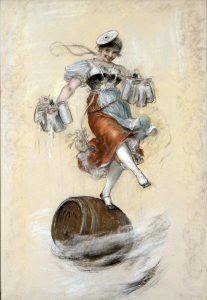 First in a series. About 44 percent of Wisconsin residents, the highest percentage of all states, reported German ancestry on the 2000 U.S. Census. (The 2010 census omitted ancestry questions).
First in a series. About 44 percent of Wisconsin residents, the highest percentage of all states, reported German ancestry on the 2000 U.S. Census. (The 2010 census omitted ancestry questions).
—
If you love beer, this is the year to visit Germany and immerse yourself in its sudsy history, regional specialties. The Reinheitsgebot – German Beer Purity Law – is 500 years old, and that means much celebrating and acknowledgement of the quincentennial with exhibits and events.
This is especially true in Bavaria, where 667 breweries operate, and they are more diverse than you might imagine. About 27 miles and 975 years separate two unusual breweries in the Munich area, home to the world’s largest Oktoberfest.
On a hilltop in Freising, just north of the city, is the world’s oldest commercial brewery. The Weihenstephan, part of a Benedictine abbey in the year 1040, produces millions of gallons of beer per year. Brewing began with holy water from a nearby spring, when beer was a vital part of daily nutrition for all ages.
Facing Heilig-Kreuz, a Catholic church in Munich, is Giesinger Brau, one of the city’s newest craft breweries. It opened in late 2014 and produces less than 800 gallons at a time.
All German breweries – regardless of size – still must abide by the Reinheitsgebot, which ensures only hops, malt, water and yeast are used to make beer. You can’t dump in berries, honey or spices to make a beer stand out from the competition.
Weinhenstephan and Giesinger Brau brewers are learning how to stay true to the purity law yet experiment with flavors, thanks in part to new strains of hops, some of which come from the United States. These crossbred plants add citrus or other aromas.
Lemondrop Triple might be on tap at Giesinger Brau, for example, where the motto is “Munich beer for Munich people” because beer is not mass marketed.
At Weihenstephan, the new 1516 lager contains a hint of banana and cloves because of an unusual yeast. The limited-edition beer is more likely to be seen in U.S. restaurants and bars than in Germany.
Vitus, a wheat beer at Weihenstephan, was rated best in the world during the 2011 World Beer Awards. The brewery is adjacent to one of only two schools in Germany that turn students from around the world into master brewers.
Robert Schamberger, a tour guide who also studies brewing science and beverage technology, describes the campus as “the Harvard of beer culture.” Researchers at his school experiment with new brewing technologies, monitor mineral levels in water, experiment with hops and yeast variations. “It’s become a complicated business,” he says.
At Giesinger Brau, Stefan Bielmeier is the 25-year-old brewmaster. “Younger people especially like the craft beer choices,” he notes. “Older people seem to stay with the industrial beers that they drank their whole life.”
Reservations are required for Weihenstephan brewery tours, which happen four times weekly. A casual restaurant at the brewery serves hearty fare and opens at 10 a.m. daily. weihenstephaner.de
Food also is served at the compact Giesinger Brau, where customers linger on the patio during good weather. giesinger-braeu.de
Next week: Getting close to nature between Munich and Berlin.
—
Other quick advice for Bavarian beer lovers:
The “Munich Six” of brewing powerhouses are Hofbrau, Augustiner, Hacker Pschorr, Lowenbrau, Paulaner and Spaten. That is one lesson of many at “Munich: Powered by Beer,” an exploration of beer history from medieval to modern times, at the Munich Stadtmuseum. The exhibit shows how brewing has intersected with politics and commerce; it remains until Jan. 8, 2017. muenchner-stadtmuseum.de
Also in place until January at the city’s Jewish Museum is “Beer is the Wine of This Land: Jewish Brewery Tales,” which focuses on the impact of beer on culture and history. juedisches-museum-muenchen.de
Instead of touring Munich’s Beer and Oktoberfest Museum on your own, consider a tour that adds beer samples, dinner, a Hofbrau Haus visit and narration in English. The 3.5-hour tour costs about $32. radiustours.com
Platzl Hotel Munich, in the oldest part of the city, is operated by a family who owns Aying Brewery. Even hotel toiletries – shampoo, soaps – contain beer. Rates begin around $125 per night. The hotel is one block from the original Hofbrau Haus, a wildly popular Oktoberfest destination (locals head to the second floor because it is quieter). platzl.de, hofbraeuhaus.de
Munich’s big Reinheitsgebot party is July 22-24, but festivities began 50 miles north on April 23, which is when the beer purity law was announced in Ingolstadt. Beer tours in Ingolstadt are conducted in English by request and reservation. Guides also offer a ghoulish nighttime tour because Ingolstadt inspired “Frankenstein” novelist Mary Shelley (the university long ago let onlookers take a seat to watch surgery at the Anatomical Institute, now a medical history museum). ingolstadt-tourismus.de
In Bamberg is a do-it-yourself beer tour. Pay about $25 at the visitors’ center for a beer trail map, shoulder bag, four vouchers for specialty beers at designated brewpubs and admission to the Franconian Brewery Museum. Within city boundaries are nine breweries, and the best-known Bamberg libation is a smoked beer. en.bamberg.info/bierschmeckertour
For more about beer and other travel in Germany, consult germany.travel. All communities mentioned are accessible by train: bahn.com.
